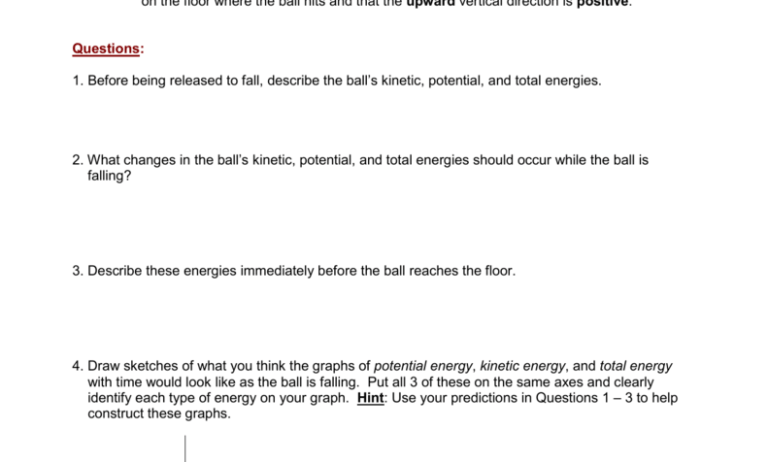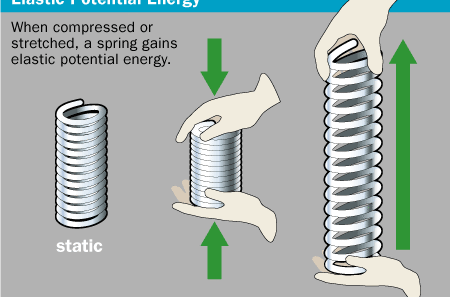The act of a ball bouncing serves as an enchanting observation that captures the imagination while simultaneously illustrating fundamental principles of physics, particularly the conservation of energy. To the casual observer, a bouncing ball may seem like a trivial demonstration of motion; however, an in-depth examination reveals a fascinating interplay of potential energy, kinetic energy, and the laws that govern their transformation. This exploration not only underscores the importance of energy conservation in a physical sense but also highlights its broader implications in our approach to sustainability and environmental consciousness.
At the very core of this phenomenon lies potential energy. When a ball is held at a certain height, it possesses gravitational potential energy, a form of energy associated with its position in a gravitational field. The amount of potential energy can be quantified using the formula: PE = mgh, where PE represents potential energy, m is the mass of the ball, g is the acceleration due to gravity, and h is the height above the ground. This stored energy is ready to be transformed.
Upon release, the ball descends, and its potential energy undergoes a metamorphosis into kinetic energy. Kinetic energy, the energy of motion, can be expressed with the equation: KE = ½ mv², where KE stands for kinetic energy, m is the mass of the object, and v represents its velocity. As the ball plummets towards the earth, it accelerates, thus increasing its kinetic energy proportionally to the square of its velocity.
Upon striking the ground, a compelling transition occurs. The kinetic energy that the ball has accumulated is executed through a collision with the surface. This interaction is not merely a simple bounce but a sophisticated exchange of energy. While some of the kinetic energy is transformed back into potential energy as the ball ascends again, it is crucial to note that not all energy is perfectly transferred. Some energy dissipates as heat and sound due to friction and deformation during impact, illustrating an important principle: energy conversions are rarely 100% efficient.
The ball reaches its highest point, momentarily suspending mid-air, where its kinetic energy dwindles to zero, and all energy reverts to potential energy once again. The cycle repeats: the ball descends, accelerates, collides, and rebounds. Yet, with every successive bounce, the height achieved becomes less than its predecessor. This gradual decline exemplifies the inevitability of energy loss in real-world systems, a stark reminder of the Second Law of Thermodynamics, which states that energy transformations increase the total entropy in a closed system.
Observing this repetitive cycle allows one to ponder broader implications regarding energy conservation. As the ball’s journey illustrates, energy cannot be created or destroyed—it is transformed. Similarly, our planet’s resources are finite, and the continuous cycle of energy consumption and waste generation must be scrutinized. The escalating demand for energy necessitates innovation in harnessing renewable sources to mitigate the impacts associated with depletion and pollution.
The bouncing ball is emblematic of a greater environmental narrative. Consider, for instance, renewable energy technologies such as solar panels and wind turbines. These systems harness natural phenomena—akin to the ball harnessing gravitational energy—to generate electricity. They exemplify the potential to create a sustainable energy loop, minimizing waste and promoting efficiency. By embracing such methods of energy capture and transformation, society can draw parallels with the bouncing ball: identifying mechanisms to enhance energy conservation at every stage of our consumption lifecycle.
Moreover, the philosophy of energy conservation extends beyond technology into personal responsibility. Much like the ball that loses height with every bounce, human activity reflects a trajectory of increased energy consumption leading to waste and environmental degradation. The challenge lies in redefining our engagement with energy—valuing efficiency and sustainability over mere abundance. Simple changes in daily habits can mirror the principles of energy efficiency; for example, minimizing waste, utilizing energy-efficient appliances, and advocating for sustainable policies contribute to a collective effort towards conservation.
The fascination with a bouncing ball transcends mere observation; it is a microcosm of the principles governing our universe and our interactions with it. The visually striking simplicity hides intricate exchanges that serve as powerful metaphors for broader ecological considerations. The acknowledgment of energy’s laws inspires individuals and communities to forge a more sustainable future, aligning energy practices with the conservation philosophy inherent in the laws of physics.
In considering the deeper reasons behind the allure of a bouncing ball, one cannot overlook the inherent beauty of physics at play. The dynamics of motion and the principles of energy conservation not only provide a captivating spectacle but also embrace vital lessons about responsibility and stewardship in our relationship with the environment. The manipulation of energy—from potential to kinetic—parallels the potential our society holds to reinvent itself towards a sustainable ethos. The fascination is not limited to a compelling display but rather opens a dialogue on the shared commitment to progress, harmony, and sustainability as we bounce forward into the future.







